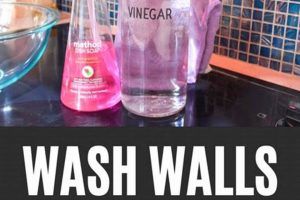A structure assembled at home, often from wire mesh cages filled with rocks, defines a retaining wall constructed through individual effort. These walls serve functional purposes, such as erosion control or landscaping features, and represent a cost-effective and customizable alternative to professionally installed retaining structures. Consider, for example, using stacked stone-filled containers to terrace a sloped backyard garden.
The appeal of this approach lies in its affordability and adaptability to diverse terrains and design aesthetics. These structures offer a balance of structural integrity and visual appeal. Historically, such retaining methods have been utilized for centuries in various forms, evolving from basic rock walls to sophisticated engineered systems. The accessible and hands-on nature of this method empowers property owners to manage land stabilization and enhance property value.
The following discussion will explore the materials, construction techniques, and design considerations involved in creating a durable and aesthetically pleasing retaining wall through individual construction. This encompasses site preparation, cage assembly, filling strategies, and long-term maintenance guidelines.
Construction Guidance
Successfully executing a rock-filled mesh container wall project requires careful planning and diligent execution. Adhering to the following guidelines will enhance the structural integrity and longevity of the finished construction.
Tip 1: Site Assessment is Crucial: Before commencing any physical construction, perform a thorough site evaluation. This includes analyzing soil composition, assessing drainage patterns, and determining load-bearing requirements. This assessment informs design choices and ensures appropriate structural support.
Tip 2: Select Appropriate Materials: Opt for galvanized or PVC-coated wire mesh for enhanced corrosion resistance. The type of rock fill should be durable and non-reactive with the surrounding environment. Consider using appropriately sized stones that interlock effectively to minimize settling.
Tip 3: Proper Cage Assembly is Essential: Assemble the wire mesh cages according to manufacturer specifications. Ensure secure connections at all seams and corners to prevent deformation or failure under load. Consider using hog rings or specialized fasteners for added strength.
Tip 4: Layered Filling Technique: Fill the cages in layers, compacting each layer to minimize voids and settling. Distribute the rock sizes evenly to create a stable and visually appealing structure. Use smaller stones to fill gaps and enhance interlocking.
Tip 5: Drainage Considerations: Integrate a drainage system behind the structure to alleviate hydrostatic pressure. This may involve installing perforated pipes and backfilling with gravel to facilitate water flow away from the retaining wall.
Tip 6: Staggered Joint Placement: When constructing multiple rows of cages, stagger the vertical joints to enhance structural stability. This prevents continuous weak points and distributes load more effectively.
Tip 7: Regular Inspections and Maintenance: Periodically inspect the structure for signs of damage or settling. Address any issues promptly to prevent further deterioration. This may involve refilling settled areas or repairing damaged wire mesh.
Following these guidelines will result in a durable and aesthetically pleasing wall structure that effectively manages soil retention and enhances landscape design.
The subsequent section will address potential challenges and troubleshooting strategies related to retaining wall construction.
1. Material selection
Material selection is a foundational element in the successful construction of a rock-filled mesh container wall. The longevity, structural integrity, and aesthetic appeal of the final structure are directly dependent on the careful consideration and selection of appropriate materials.
- Wire Mesh Composition and Coating
The composition of the wire mesh, typically steel, dictates its tensile strength and resistance to deformation under load. Galvanization or PVC coating provides crucial protection against corrosion caused by environmental exposure and soil contact. For instance, using non-coated steel mesh in acidic soil will lead to premature degradation and structural failure, necessitating costly repairs or complete reconstruction.
- Rock Fill Durability and Size
The type of rock used as fill influences both the structural stability and visual characteristics of the wall. Durable, non-reactive rock, such as granite or basalt, is preferred to minimize weathering and chemical breakdown. Rock size must be appropriately scaled to the mesh aperture to prevent loss of material and ensure proper interlocking. Utilizing excessively small rocks may compromise structural integrity, while oversized rocks can make compaction difficult.
- Fastener Specifications and Corrosion Resistance
The fasteners used to assemble the wire mesh cages play a critical role in maintaining structural integrity. Hog rings, clips, or lacing wire must be manufactured from a corrosion-resistant material, such as stainless steel or galvanized steel, to prevent failure due to rust or oxidation. The gauge and tensile strength of the fasteners must also be adequate to withstand the stresses imposed by the rock fill and surrounding soil. Using inadequate fasteners may lead to separation of the mesh panels and subsequent structural collapse.
- Geotextile Fabric for Soil Separation and Drainage
The inclusion of geotextile fabric behind the wall is crucial for preventing soil erosion and maintaining proper drainage. This fabric acts as a filter, allowing water to pass through while preventing soil particles from migrating into the rock fill. Choosing the correct geotextile fabric with appropriate permeability and filtration characteristics is essential for long-term performance. Improper selection can lead to clogging, reduced drainage efficiency, and increased hydrostatic pressure behind the wall.
The strategic selection of these materials ensures a wall that is not only structurally sound and visually appealing, but also resistant to the environmental stressors that can compromise its long-term viability. Consideration of these factors during the planning phase will contribute significantly to the overall success and sustainability of the retaining structure.
2. Structural Integrity
Structural integrity is paramount in any retaining wall construction, and projects are no exception. The arrangements ability to withstand lateral earth pressure, surcharge loads, and environmental factors hinges directly on the soundness of its design and construction. Failure to adequately address structural integrity concerns can lead to wall collapse, soil erosion, property damage, and potential safety hazards. For example, a wall constructed with undersized wire mesh or insufficient internal bracing will likely deform or fail under the weight of saturated soil following a heavy rainfall. The use of appropriate materials, proper construction techniques, and adherence to established engineering principles are essential for ensuring the long-term stability and functionality of these structures.
Achieving adequate structural integrity involves several key considerations. These include selecting wire mesh with sufficient tensile strength, employing proper cage assembly techniques to ensure secure connections, using appropriately sized and graded rock fill to maximize interlocking and minimize voids, and integrating a drainage system to alleviate hydrostatic pressure behind the wall. Moreover, consideration must be given to the soil conditions at the site, including soil type, moisture content, and slope angle. For instance, a wall constructed in an area with highly expansive clay soil will require additional reinforcement and drainage measures to prevent movement and cracking. Understanding these factors and incorporating them into the design and construction process is crucial for mitigating the risks associated with retaining wall failure.
In summary, structural integrity represents a non-negotiable aspect of projects. Ignoring or underestimating its importance can have severe consequences. By prioritizing proper planning, material selection, construction techniques, and site-specific considerations, it is possible to create stable, durable, and aesthetically pleasing walls that effectively serve their intended purpose and provide lasting value. The initial investment in sound design and construction practices will ultimately prove more cost-effective than the expense and disruption associated with repairing or replacing a structurally deficient retaining wall.
3. Erosion Control
Erosion control constitutes a primary function and significant benefit derived from employing individually constructed rock-filled mesh container walls. These structures mitigate soil loss caused by water runoff, wind action, and gravity. Uncontrolled erosion leads to land degradation, sedimentation of waterways, and damage to infrastructure. The effectiveness of a wall in erosion control depends on its proper design, construction, and integration with the surrounding landscape. Consider, for example, the use of a terraced system of walls to stabilize a steep hillside prone to landslides. This approach reduces the slope angle, intercepts runoff, and provides a stable foundation for vegetation, effectively minimizing erosion risk.
The interconnectedness of wall construction and erosion control extends beyond simple physical barrier creation. These walls influence hydrological processes by slowing water flow, promoting infiltration, and reducing the erosive force of surface runoff. The permeable nature of these structures allows water to drain freely, preventing the buildup of hydrostatic pressure that could destabilize the wall itself and exacerbate erosion. Moreover, the spaces between rocks within the structure provide habitat for vegetation, whose roots further stabilize the soil and enhance erosion resistance. An example of this is the planting of native grasses and shrubs on and around the structure to reinforce soil stability and enhance the visual appeal.
In summary, erosion control forms an intrinsic element of retaining wall functionality. These structures offer a practical and adaptable solution for managing soil loss in diverse environmental settings. Recognizing the critical role of erosion control in planning and constructing a rock-filled mesh container wall ensures long-term soil stability, environmental protection, and preservation of property value. Careful consideration of site-specific conditions, material selection, and construction techniques is essential for maximizing the erosion control benefits of this retaining wall approach.
4. Cost-effectiveness
Cost-effectiveness represents a significant consideration for individuals contemplating retaining wall construction. The comparative affordability of this method frequently drives its selection over professionally installed alternatives, presenting both opportunities for savings and potential trade-offs that warrant careful evaluation.
- Reduced Labor Expenses
The primary cost reduction stems from the elimination of professional labor fees. The construction relies on individual or small group effort, bypassing the expense associated with hiring specialized contractors. Consider a homeowner with basic construction skills undertaking the project during weekends, thereby converting personal time into direct cost savings, albeit potentially extending the project timeline.
- Use of Locally Sourced Materials
Significant savings can be realized by utilizing locally sourced rock fill. This minimizes transportation costs and leverages readily available resources. For instance, a property owner near a quarry may be able to acquire suitable rock fill at a fraction of the cost compared to purchasing manufactured retaining wall blocks, although material quality and consistency must be carefully assessed.
- Phased Construction Approach
The modular nature of this construction allows for a phased approach, distributing costs over time. This is particularly beneficial for projects with budgetary constraints. The wall can be built in stages, adding sections as funds become available, enabling incremental investment rather than a large upfront expenditure.
- Lower Maintenance Requirements
When properly constructed with durable materials, retaining walls exhibit relatively low maintenance requirements compared to some other retaining wall systems. This translates to long-term cost savings by minimizing the need for frequent repairs or replacements, though periodic inspections are still recommended to ensure structural integrity.
These facets highlight the potential cost advantages associated with building the walls. However, it is crucial to acknowledge that these savings can be offset by factors such as increased project duration, potential for construction errors due to lack of expertise, and the need for specialized tools or equipment. A comprehensive cost-benefit analysis, considering both direct expenses and indirect factors, is essential for determining the true cost-effectiveness of this approach in a specific context.
5. Aesthetic appeal
The visual integration of a retaining wall project with its surrounding environment plays a crucial role in its overall success. The aesthetic appeal transcends mere functionality, influencing property value, landscape harmony, and the perception of quality and craftsmanship.
- Material Color and Texture Palette
The selection of rock fill materials dictates the predominant color and texture of the wall. Using locally sourced stone can create visual continuity with the existing landscape, promoting a natural and harmonious appearance. Conversely, incorporating contrasting colors or textures can create a focal point and add visual interest. Examples include using light-colored limestone to brighten a shaded area or incorporating rough-textured fieldstones for a rustic aesthetic. The careful coordination of color and texture with the surrounding architecture and landscaping contributes significantly to the aesthetic appeal.
- Cage Arrangement and Design Patterns
The arrangement of cages allows for creative design patterns that enhance the visual appeal. Staggering the cages, varying their size, or incorporating curves and angles can create a more dynamic and visually engaging structure. Incorporating plants into the wall structure, such as cascading vines or flowering shrubs, can soften the appearance and blend the wall seamlessly with the landscape. The strategic placement of plants can also create vertical interest and provide seasonal color variations.
- Integration with Landscape Features
A wall is most visually effective when integrated seamlessly with existing landscape features. This can involve incorporating existing trees, shrubs, or rock outcroppings into the design. Adding features such as steps, pathways, or seating areas adjacent to the wall can enhance its functionality and create a cohesive outdoor living space. The integration of lighting can further enhance the aesthetic appeal, highlighting the texture and form of the wall and creating a welcoming ambiance.
- Consideration of Site Lines and Visibility
The aesthetic impact of a wall is influenced by its visibility and how it is perceived from various vantage points. The design should consider site lines from the house, garden, and surrounding properties. Minimizing the visual impact of the wall by blending it with the landscape can be desirable in some situations, while in others, creating a prominent and visually striking feature may be the goal. Understanding the visual context and tailoring the design accordingly is crucial for achieving the desired aesthetic effect.
These facets, when thoughtfully considered and implemented, elevate a wall from a purely functional structure to an aesthetically pleasing landscape element. The visual impact of the project should be carefully evaluated to ensure it complements and enhances the overall beauty and value of the property.
Frequently Asked Questions
The following addresses common inquiries regarding the planning, construction, and maintenance of individually built rock-filled mesh container walls.
Question 1: What are the primary applications for a individually constructed rock-filled mesh container wall?
These structures serve multiple purposes, including soil retention on sloped terrains, erosion control along waterways, creation of terraced garden beds, and aesthetic landscaping features. Their versatility allows adaptation to diverse environmental and design requirements.
Question 2: What materials are essential for building a durable rock-filled mesh container wall?
Key materials include galvanized or PVC-coated wire mesh for cage construction, durable and appropriately sized rock fill, corrosion-resistant fasteners (hog rings or lacing wire), and geotextile fabric for drainage and soil separation. Material selection impacts the structure’s longevity and stability.
Question 3: What site preparation is necessary before commencing construction?
Proper site preparation involves clearing vegetation, leveling the ground, assessing soil composition, and establishing adequate drainage. A stable and well-drained foundation is crucial for preventing settling and structural failure.
Question 4: How does one ensure adequate drainage behind a rock-filled mesh container wall?
Effective drainage is achieved by installing a layer of gravel behind the wall, incorporating perforated drainage pipes, and using geotextile fabric to prevent soil migration. This minimizes hydrostatic pressure, reducing the risk of wall deformation or collapse.
Question 5: What are the potential challenges associated with constructing a individually constructed rock-filled mesh container wall?
Challenges can include difficulty in leveling the site, ensuring proper cage alignment, sourcing suitable rock fill, and managing the weight of the materials. Careful planning, attention to detail, and adherence to construction guidelines are essential for mitigating these challenges.
Question 6: How does one maintain a rock-filled mesh container wall to ensure its long-term stability?
Regular inspections are necessary to identify signs of settling, deformation, or corrosion. Addressing issues promptly, such as refilling settled areas or repairing damaged mesh, prevents further deterioration and extends the lifespan of the structure.
Proper planning, material selection, construction techniques, and maintenance are crucial for creating a durable and aesthetically pleasing retaining structure.
The subsequent section will delve into advanced design considerations and explore innovative applications for retaining walls.
DIY Gabion Wall
The preceding exploration has examined facets of the individually constructed rock-filled mesh container wall, addressing its construction, advantages, and potential challenges. Considerations regarding material selection, structural integrity, erosion control, cost-effectiveness, and aesthetic integration have been detailed. It is essential to acknowledge that the successful implementation of a project hinges on thorough planning, meticulous execution, and a comprehensive understanding of site-specific conditions.
The information provided serves as a foundational resource for those contemplating this construction method. While this approach offers considerable autonomy and potential cost savings, adherence to sound engineering principles and local building codes remains paramount. Diligent planning and execution will determine the long-term stability and aesthetic value of the finished structure.







